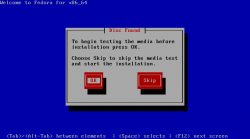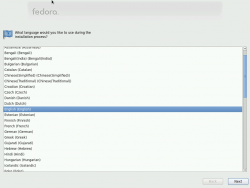(Created page with 'Anaconda Consists of two stages: * First stage starts the installation * Second stage performs the installation anaconda is execute in two stages. The first stage boots the syst...') |
|||
| (17 intermediate revisions by 4 users not shown) | |||
| Line 1: | Line 1: | ||
Installer is executed in two stages. The loader(old stage#1) starts the installation, and anaconda(old stage#2) performs the installation. | |||
When installing fedora, distinguishing loader with anaconda is easy: | |||
* '''loader''' only contains blue text-box user interface. | |||
: [[Image:anaconda-stage1.png|250px|Anaconda stage 1]] | |||
* '''anaconda''' begins from the first gui/gtk page after ''Running anaconda <version>, the <product> system installer - please wait''. | |||
: [[Image:anaconda-stage2-F15.png|250px|Anaconda stage 2]] | |||
In fedora, the loader(old stage#1) loads anaconda, the Fedora installer. It consists of a special kernel and initrd.img. These files can be loaded by any supported bootloader. Images for alternative installation boot media can be found on the first installation disk or installation DVD. The loader parses command line arguments and then initializes the selected mode of the Installer. After booting the system and performing initialization of the system, it will then load the anaconda(old stage#2) from the selected installation medium. The key for telling which stage you're in across all modes of installation is the ''Running anaconda <version>, the <product> system installer'' message. | |||
by the first | |||
Latest revision as of 05:44, 17 October 2011
Installer is executed in two stages. The loader(old stage#1) starts the installation, and anaconda(old stage#2) performs the installation.
When installing fedora, distinguishing loader with anaconda is easy:
- loader only contains blue text-box user interface.
- anaconda begins from the first gui/gtk page after Running anaconda <version>, the <product> system installer - please wait.
In fedora, the loader(old stage#1) loads anaconda, the Fedora installer. It consists of a special kernel and initrd.img. These files can be loaded by any supported bootloader. Images for alternative installation boot media can be found on the first installation disk or installation DVD. The loader parses command line arguments and then initializes the selected mode of the Installer. After booting the system and performing initialization of the system, it will then load the anaconda(old stage#2) from the selected installation medium. The key for telling which stage you're in across all modes of installation is the Running anaconda <version>, the <product> system installer message.


